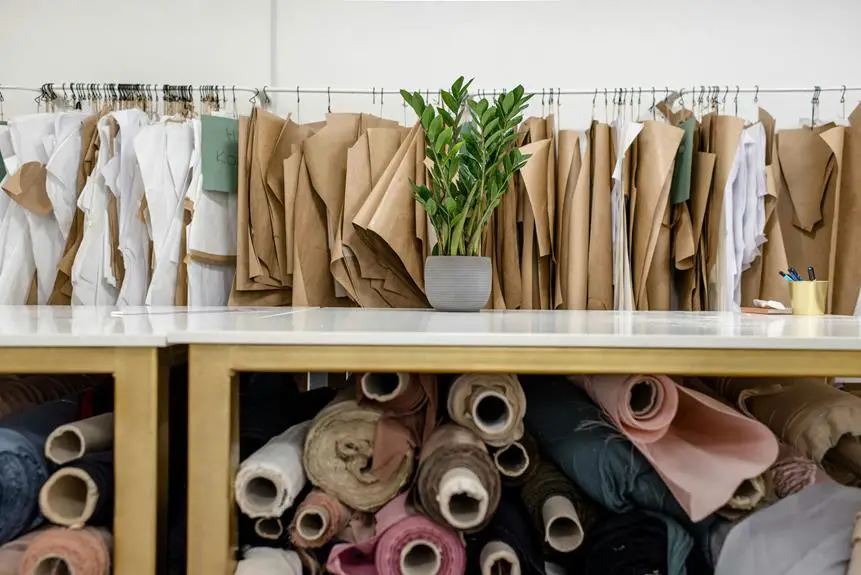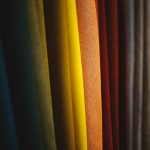When you think about the evolution of fashion, taffeta often stands out as a fabric that has woven itself into the very fabric of history. Its journey from ancient Persia to the opulent gowns of the Victorian era reveals layers of cultural significance and social status. You might wonder how this one material managed to captivate the elite across centuries, shaping silhouettes and influencing trends. As we explore its various roles, you'll see just how taffeta's story unfolds—and perhaps discover what it tells us about the society that cherished it.
Table of Contents
Origins of Taffeta
Taffeta originated in ancient Persia, where it was woven from silk and prized for its luxurious sheen and crisp texture. As you explore its history, you'll discover that this fabric became a symbol of wealth and sophistication. The intricate weaving techniques developed by Persian artisans allowed taffeta to catch the light beautifully, making it a favorite among royalty and the elite.
When you think about taffeta, imagine its versatility. It's not just about elegance; the fabric was used for various garments, from flowing gowns to structured jackets. Its stiffness gave designers the ability to create voluminous silhouettes that turned heads at royal courts and events.
As trade routes expanded, taffeta made its way to Europe, where it continued to gain popularity. You might picture merchants exchanging this prized fabric for spices and other goods, further cementing its status as a luxury material.
In essence, taffeta's origins are steeped in a rich history of craftsmanship and opulence. Understanding this background enriches your appreciation for the fabric and its enduring appeal in fashion throughout the ages.
Taffeta in the Middle Ages
In the Middle Ages, taffeta emerged as a favored fabric among the wealthy, prized for its crisp texture and lustrous finish.
You'll notice how its vibrant colors and elegant drape influenced fashion trends of the era, as it was often used in garments for nobility.
Let's explore how this luxurious material shaped the clothing styles of the time.
Taffeta's Origin and Use
Originating in the East, this lustrous fabric made its way to Europe during the Middle Ages, captivating the nobility with its elegance and versatility. You'll find that taffeta, woven from silk or rayon, became a symbol of wealth and status. Its smooth texture and sheen made it perfect for formal garments, often used in gowns and elaborate sleeves.
As you explore its use, you'll notice that taffeta was also favored for linings and undergarments. The fabric's crispness helped create structured silhouettes that highlighted the wearer's figure. Nobles would often choose vibrant colors, showcasing their affluence and taste.
During this period, taffeta wasn't just about aesthetics; it also served practical purposes. Its durability allowed garments to withstand the wear of courtly life, while its water-resistant qualities made it suitable for various weather conditions.
You might appreciate how craftsmen experimented with different weaving techniques, leading to variations like shot taffeta, which displayed different colors depending on the angle of light. This innovation kept taffeta in high demand, solidifying its place in the fabric hierarchy of the Middle Ages.
Fashion Trends of Era
Embodying the elegance of the Middle Ages, taffeta became a staple in the wardrobes of the nobility, shaping the fashion trends of the era. As you explore this period, you'll notice how taffeta's crisp texture and lustrous finish elevated garments, making them more appealing. Nobles often chose rich colors and intricate patterns, which showcased their wealth and status.
You'll see taffeta used in gowns, tunics, and even accessories. Women wore flowing dresses adorned with elaborate sleeves, while men sported tailored doublets, both emphasizing the fabric's luxurious qualities. The material's ability to hold shape contributed to the dramatic silhouettes favored during this time.
Fashion also embraced embellishments. You'd find embroidered details, lace trims, and jewels adorning taffeta garments, enhancing their allure. As you delve deeper, you'll recognize that taffeta wasn't just about aesthetics; it symbolized power and prestige.
In courtly settings, your attire could dictate your social standing, and wearing taffeta signified a connection to the elite. By understanding these trends, you can appreciate how taffeta influenced the cultural fabric of the Middle Ages, leaving a lasting legacy in fashion history.
The Renaissance and Taffeta
During the Renaissance, taffeta emerged as a luxurious fabric that enhanced the grandeur of fashion, captivating the elite with its crisp texture and shimmering appearance. You'd find taffeta gracing the gowns of noblewomen and the garments of affluent men, serving as a symbol of wealth and sophistication.
The fabric's unique qualities made it a favorite for various purposes, including:
- Gowns: Taffeta's structure allowed for elaborate designs and voluminous skirts that highlighted the wearer's status.
- Breeches: Men often wore taffeta breeches, showcasing their fashion sense and social standing.
- Accessories: Taffeta was used in cuffs, collars, and ribbons, adding a touch of elegance to any outfit.
- Decorative Elements: The fabric adorned interiors, highlighting the opulence of Renaissance homes with its reflective properties.
As you explore this vibrant period, you'll notice how taffeta's versatility played a crucial role in defining the aesthetic of the time. Whether in clothing or decor, it created an atmosphere of luxury that still resonates in modern fashion.
Embracing taffeta meant embracing a lifestyle of refinement and taste during this pivotal era.
Taffeta's Role in Victorian Fashion
Taffeta played a crucial role in Victorian fashion, thanks to its luxurious texture that added elegance to any ensemble.
You'll find it was especially popular in evening wear, where the fabric's sheen created a stunning effect in candlelight.
Moreover, its structural qualities allowed for intricate designs and silhouettes that defined the era's style.
Taffeta's Luxurious Texture
Known for its crisp, smooth finish, taffeta became a favored choice for Victorian gowns, enhancing the elegance and grandeur of the era's fashion. You can easily see why this luxurious fabric was so popular. Its unique texture contributed to the dramatic silhouettes that defined the period, making women feel both sophisticated and regal.
Here are four key features of taffeta's luxurious texture that made it stand out:
- Crispness: Taffeta holds its shape exceptionally well, allowing for voluminous skirts and elaborate designs that captured the eye.
- Sheen: The fabric's lustrous surface reflects light beautifully, adding a touch of glamour to any gown.
- Lightweight: Despite its structure, taffeta remains light, making it comfortable to wear while maintaining a striking appearance.
- Versatility: Available in a variety of colors, taffeta could be dyed to suit any occasion or personal style, making it a staple in Victorian wardrobes.
Embracing taffeta meant embracing a fabric that embodied the opulence of the Victorian era, allowing you to step into a world of exquisite fashion and timeless beauty.
Popularity in Evening Wear
Evening wear in the Victorian era thrived on the elegance and sophistication that taffeta brought to the table, making it a go-to choice for formal occasions. You'd find taffeta dresses at balls, soirées, and grand dinners, where the fabric's lustrous finish and crisp texture added a touch of glamour. Women loved how taffeta enhanced their silhouettes, creating an air of refined grace that was essential for social gatherings.
The versatility of taffeta allowed for a variety of evening styles, from full skirts to fitted bodices. You could choose rich colors like deep green, royal blue, or classic black, ensuring your gown stood out in any crowd. The fabric's ability to hold shape meant that embellishments like bows, ruffles, or pleats could be incorporated effortlessly, making each dress unique and eye-catching.
Moreover, taffeta's lightweight nature made it comfortable to wear, allowing you to dance the night away without feeling restricted. As the Victorian era progressed, taffeta continued to dominate evening wear, solidifying its status as a symbol of luxury and refinement in fashion history.
Structural Designs and Silhouettes
Victorian fashion thrived on structural designs that emphasized dramatic silhouettes, and taffeta played a crucial role in achieving those stunning looks. This lustrous fabric's crispness helped create volume and shape, which were hallmarks of the era. You'd find taffeta in various garments, each showcasing its unique qualities.
Here are four key aspects of taffeta's role in structural designs:
- Ball Gowns: Taffeta's stiffness allowed for fuller skirts, which were essential for the extravagant silhouettes of Victorian ball gowns.
- Corsetry: The fabric's supportiveness complemented tightly laced corsets, enhancing the hourglass figure that was so coveted during this time.
- Layering: Designers often layered taffeta with other materials, creating depth and texture that contributed to the overall structure of the outfit.
- Trimmings: Taffeta's ability to hold shape made it ideal for elaborate trimmings like ruffles and bows, adding to the drama of the silhouette.
Taffeta in the 20th Century
Taffeta made a striking comeback in the 20th century, becoming a staple in both high fashion and everyday wear. Designers embraced its crisp texture and ability to hold shapes, making it ideal for creating structured silhouettes. You'd find taffeta in ball gowns, cocktail dresses, and even wedding attire, with its reflective surface adding a touch of glamour to any occasion.
The fabric also played a significant role in the 1950s when the New Look silhouette dominated fashion. Designers like Christian Dior showcased taffeta in skirts that flared dramatically, enhancing the hourglass figure. As the decades progressed, you'd see taffeta being used in less formal garments, like blouses and skirts, appealing to a broader audience.
In the 1980s, taffeta's popularity soared again, fueled by bold colors and extravagant designs. You might remember the ruffled, oversized styles that defined the era, bringing a sense of drama to everyday fashion. Taffeta wasn't just for the elite anymore; it became accessible, appearing in ready-to-wear collections and adding a vibrant touch to casual outfits.
Through the 20th century, taffeta stayed versatile and relevant, proving its enduring charm and adaptability.
Modern Interpretations of Taffeta
Modern designers are reinventing taffeta, blending its classic elegance with contemporary styles to create fresh, innovative looks for today's fashion enthusiasts.
You'll find taffeta making a comeback in various forms, showcasing its versatility and ability to adapt to modern trends.
Here are some ways designers are incorporating taffeta into modern fashion:
- Layered Textures: Taffeta is often layered with other fabrics, providing depth and dimension to garments, making them visually captivating.
- Bold Colors and Patterns: Designers are experimenting with vibrant hues and prints, moving away from traditional monochromatic styles, appealing to a younger audience.
- Sustainable Practices: As environmental awareness grows, many brands are sourcing taffeta from eco-friendly materials, aligning with the sustainable fashion movement.
- Street Style: Taffeta is showing up in casual wear, like oversized jackets or skirts, proving it can transition from formal events to everyday outfits.
These modern interpretations keep taffeta relevant, allowing you to embrace its unique charm while enjoying the fresh perspective it brings to your wardrobe.
Taffeta's Cultural Significance
Throughout history, taffeta has played a crucial role in various cultures, symbolizing elegance and status in fashion. When you think of taffeta, you often envision lavish gowns or sophisticated evening wear. This fabric has been a favorite among the elite, especially during the Renaissance and Victorian eras, where it adorned the dresses of royalty and high society.
You'll notice how taffeta's crisp texture and luxurious sheen elevate garments, making them suitable for significant cultural events like weddings and galas. In many cultures, wearing taffeta signifies a celebration or important milestone, reflecting the wearer's social standing.
Today, taffeta's cultural significance persists in formal attire, with designers using it to evoke a sense of grandeur. You might see it in bridal collections, where the fabric creates dramatic silhouettes, or in evening dresses that capture attention on the red carpet.
Taffeta isn't just a fabric; it's a statement of grace and sophistication. So, when you choose taffeta for your wardrobe, you're not just opting for a pretty fabric; you're embracing a rich history that resonates with elegance and cultural importance.
Frequently Asked Questions
How Is Taffeta Different From Other Fabrics?
Taffeta's crisp texture and smooth finish set it apart from other fabrics. It's lightweight yet structured, making it ideal for formal wear. You'll appreciate its ability to hold shapes and create elegant silhouettes effortlessly.
What Are Common Uses for Taffeta Today?
Today, you'll find taffeta used in evening gowns, bridal wear, and elegant drapery. Its crisp texture adds structure, making it perfect for formal occasions, while its sheen enhances the overall visual appeal of garments.
Is Taffeta Environmentally Friendly?
Taffeta isn't typically considered environmentally friendly due to its synthetic origins. When you choose taffeta, you're opting for a fabric that may not biodegrade easily and can contribute to pollution in the fashion industry.
How Do You Care for Taffeta Garments?
To care for taffeta garments, you should dry clean them to maintain their texture. If washing at home, use cold water and a gentle detergent, then lay flat to dry to prevent wrinkles and damage.
What Colors and Patterns Are Popular in Taffeta?
When choosing taffeta, vibrant colors like emerald green, royal blue, and deep red stand out. Bold patterns, such as florals and geometric designs, add flair. You'll find plenty of options to suit your style!
- Can I Wear Corduroy Pants With a Tweed Jacket? Fashion Tips Inside - July 4, 2025
- Can You Wear Corduroy Pants With a Blazer for Stylish Comfort? - July 4, 2025
- Stylish Shoe Choices for Women to Wear With Corduroy Pants - July 4, 2025







